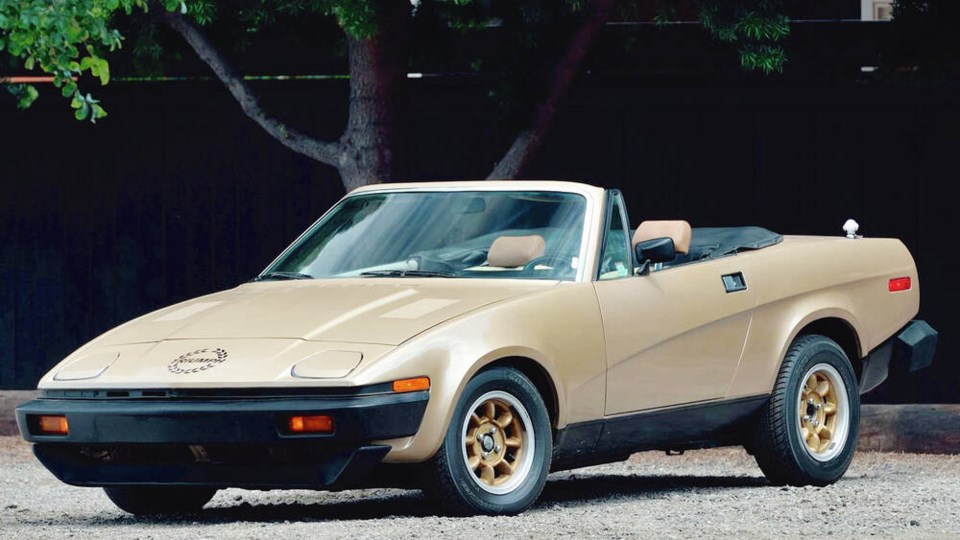The Triumph Cycle Co. of Coventry, Warwickshire, established in 1887, was known for bicycles, motorcycles and motorized three-wheelers long before it began building cars in 1923. It became the Triumph Motor Co. in 1930 and produced a variety of sedans and sporty cars including the Super Seven, Super Eight, Gloria and Dolomite.
Its most daring venture was the ambitious 1934 Triumph Dolomite Straight Eight powered by a double overhead cam, 140 horsepower two-litre inline eight. It was a knock-off of the Italian Alfa Romeo 8C 2300 but financial constraints limited production to three. Triumph went into receivership during the Second World War and was bought in 1944 by the Standard Motor Co. to become a subsidiary of Standard.
After the war, Triumph cars, now Standard-based, came as the 1800 (later Renown) mid-size sedan and sub-compact Mayflower sedan, both with razor edge styling reminiscent of such 1930s luxury cars as the Rolls-Royce. There was also a rather quaint 1946-1949 1800/2000 Roadster, the last production car with a rumble seat. It was slow and expensive and had limited sales.
Standard began exporting Triumphs to Canada and the United States in 1948 with modest success. That situation changed dramatically with the arrival of the car that really brought Triumph to North American attention, the 1954 TR2 sports car.
It had a twin carburetor, 90 horsepower two-litre modified Standard Vanguard four. Its performance far overshadowed the popular MG and approached that of the larger engined Austin-Healey.
The Triumph TR series was very successful for Standard Motor Co. It evolved through the TR3, TR3A et al., up to the TR6 of the 1970s, now with a 2.5-litre overhead valve six. TRs were all based on the original TR2 platform until the TR6, by which time it had reached the limit of its development.
Following a series of acquisitions and mergers, by 1975 Triumph was part of largely state-owned British Leyland Ltd., and former competitors MG and Triumph found themselves under the same corporate roof. BL management decided to concentrate on the Triumph sports car, allowing MG development to languish.
Thus the MGB soldiered on virtually unchanged while an all-new Triumph TR7 arrived in 1975. And “all-new” it was. Whereas the TR6 was a body-on-frame roadster with four-wheel independent suspension, the TR7 was a unit construction coupe with a beam rear axle.
It was not powered by a six like the TR6, which continued for another year, but a two-litre (1998 cc) single overhead cam four. This engine was also fitted to the Triumph Dolomite (post-war) sedan and sold to Saab who used it as the basis for its 99, 900 and 9000 model engines. In the TR7 it was tilted 45 degrees to the left allowing easy access to the two Stromberg carburetors.
It had rack-and-pinion steering and suspension was MacPherson struts in front and coil springs at the rear. Brakes were disc front and drum rear.
TheTR7’s 90 horsepower accelerated the 1,068 kg (2,355 lb) coupe to 97 km/h (60 mph) in 11.3 seconds and achieved a top speed of 174 km/h (108 mph) (Road & Track 5/75).
This was close to the TR6’s performance and only marginally better than the original TR2’s zero to 97 (60) time of 12.2 seconds and 166 km/h (103 mph) top speed (R&T 4/54). This illustrated how emission controls were stifling performance.
The TR7’s styling by British Leyland was decidedly wedge-shaped and could not really be called elegant. It appeared short and wide and would have benefited from some of the magic that Italian stylist Giorgetto Giugiaro demonstrated in such exquisite designs as the Lotus Espirt and Volkswagen Sirocco.
TR7 assembly was a disjointed affair reflecting the somewhat chaotic condition the British auto industry was sliding into. Production began in Liverpool and was moved to Coventry three years later, which resulted in part of a-year’s loss of production. Then in 1980 it was relocated yet again to the Rover plant in Solihull west of Coventry.
The results of production disruptions and periodic union militancy were apparent in the TR7’s somewhat indifferent quality control that negatively impacted sales.
A TR7 coupe was joined by a convertible in 1979 which seemed to show its styling to better advantage. Unhappily for the TR7, Britain’s auto industry was fading on the world stage against strong competitors like the Japanese with such outstanding sports cars as the Datsun Z-series and Mazda RX7.
In spite of several strikes against it, by the time TR7 production ceased in 1981 more than 112,000 had been built. It was replaced by the short-lived TR8, a TR7 fitted with the General Motors-designed 3.5 litre aluminum overhead valve V-8.
The TR7 was a good attempt at reviving Britain’s waning sports car leadership, but it came too late and with too many problems.



